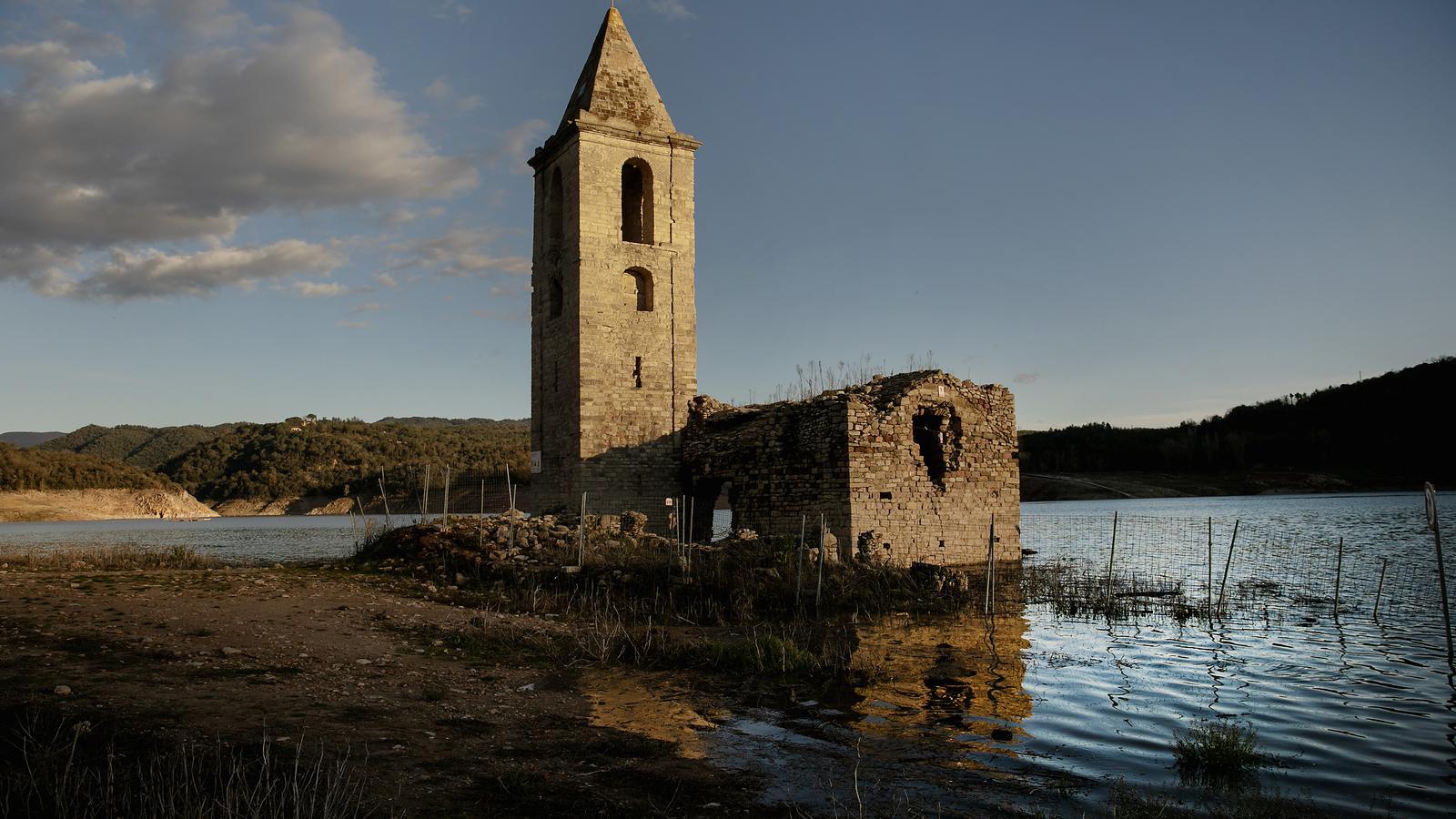In the 1950s, the new village of Sant Romà de Sau was created. Contrary to what one might think, it was not built to replace the old one, but to house the dam construction workers and their families. At one time, around 600 people lived there, but the population fluctuated greatly, varying depending on the construction work. A new church was built in the new village, designed by architect Josep Maria Pericas. When it came time to replace the bells from the old Sant Romà de Sau church in the new one, it turned out they didn't fit. They were too big. New ones had to be made.
Symbol of the country's water reserves
The Sau reservoir


The bell tower of the Church of Sant Román de Sau (11th century, Lombard Romanesque style), which overlooks the water, is probably the most important symbol of the country's water resources, both during drought and during times of abundance. It tells us how water reserves are in Catalonia.
"I've seen the bell tower completely submerged (during Storm Gloria in 2020; a buoy was placed there to prevent boats from entering) and also a good part of the village's houses, when there was very little water. During the last drought, the reservoir reached 1.5% of its depth. The old village. Everyone said that the bridge would be destroyed by the water pressure, and it's still there," Meritxell Font, a municipal information provider and historian who gives guided tours of the old village of Sant Romà—which was flooded—tells me on the banks of the reservoir, next to the yacht club. Her family lived in Sant Romà. Her father lived there until he was seven. "It was a slow death," my father, Àngel Font, tells me. "It had been talked about for a long time. No one touched a single tile on their house because they knew they were doomed," Ángel comments. "We were excited to have a new house," he recalls. "Leaving that place wasn't a big deal," says Ángel, who has many vivid and beautiful memories of his childhood in Sant Romà: he received his first communion in the church, he used to go swimming in the river, fishing...
The journalist Miquel Macià explains in the book History of the construction of the Sau Reservoir, by Joan Lagunas, who was visited by German journalists: they wanted to speak with "survivors" of the old Sau Valley to explain how they had suffered. They would have missed out on everything that life, outside on the plain of Vic, had given them.
"In one of my grandfather's drawers, I found this photo," Meritxell tells me, showing me a black-and-white paper image showing piled-up tiles and beams. "All of this belonged to the houses. It was ready to be sold or relocated." The town was dismantled, then. Except for the church. It faded away. Over the course of twenty years, "the smoked ones" left. That's what the inhabitants of Sant Romà de Sau were called: the smell of the charcoal fire permeated their clothes and skin. The work of making charcoal, especially with holm oak wood, was widespread. "In winter, my grandfather told me, you could see the columns of smoke coming out of the charcoal pits everywhere," Meritxell says as a boat passes by, pulling a man water-skiing, who falls. I think about the damage that's been done. In a water-ski fall, the water looks like stone.
Before the dam, the Sau Valley was an isolated and difficult-to-access area. It had been a refuge for bandits in the 16th and 17th centuries. It was home to the second-in-command of Serrallonga, Jaume Malianta, "the bachelor of Sau." Banditry explains why some of the village's houses had underground passageways.
Sau, Susqueda, and Pasteral function as a single dam, as they are linked or cascaded. The Sau reservoir was built for four reasons: to regulate the flooding of the Ter River (and thus prevent flooding in Girona); to store water and ensure it is used for industrial and irrigation purposes in the area (until then, it was obtained from small irrigation ditches); and to supply drinking water to Barcelona, the metropolitan area, and part of the Costa Brava.
The stretch of river where the site was decided upon was known as the "gorge of the whirlpools." It was narrow, with steep slopes. The water flowed rapidly, all of which was ideal for the construction of the dam. Furthermore, both the riverbed and banks were made of granite rock (hard, compact, and durable, ideal for cement production).
Planning for the reservoir began in the 19th century. Shortly after the end of the Civil War, in 1942, construction began. Initially, the workers were prisoners. The prisons were overcrowded, and a few were released to carry out public works.
Settled in the "Camp of the Ter," commanded by an army captain with the support of a Falangist guerrilla group, the workers endured grueling work days. Working conditions were appalling, and the food was substandard. Safety measures were insufficient—or nonexistent—and accidents were kept quiet.
On September 13 (Tuesday the 13th!), 1963, the "authorities" ordered the floodgates to be completely closed. The reservoir quickly filled. A typical late-summer storm had been persisting for days, so the Ter River was running high and the city of Girona was in clear danger of dangerous flooding. The terrible Vallès downpour of 1962, which caused many deaths, was still fresh in memory.
